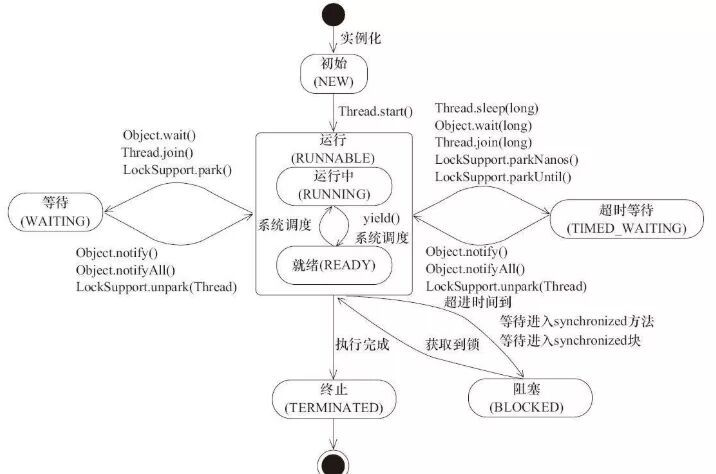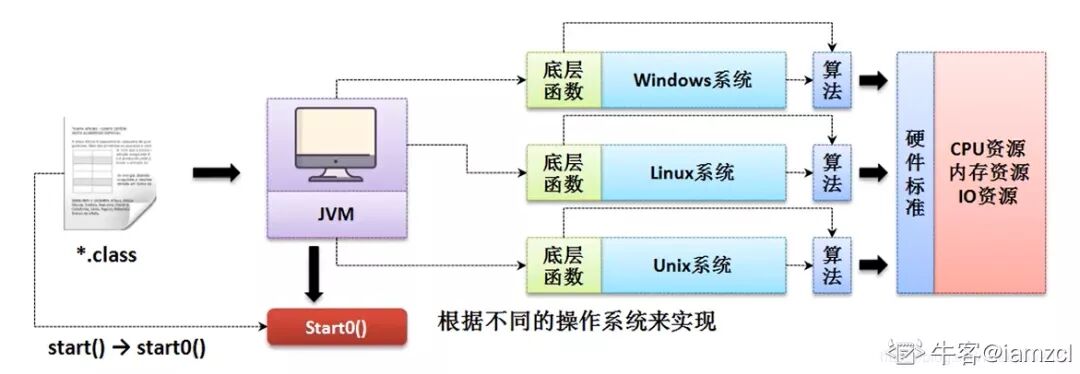多线程在工作中多多少少会用到,启动多线程调用的是 start() 方法,而不是 run() 方法,这是为什么呢?
在探讨这个问题之前,先来了解(复习)一些多线程的基础知识~
线程的状态
Java 中,定义了 6 种线程状态,在 Thread 类可以找到:
- // 为了节约空间,我删除了注释
- public enum State {
- NEW,//初始状态
- RUNNABLE,//运行状态
- BLOCKED,// 阻塞状态
- WAITING,//等待状态
- TIMED_WAITING,//超时等待状态
- TERMINATED;//终止状态
- }
这 6 种状态之间的关联,可以看下面这张图:
这张图描述的还是非常详细的,结合这张图,来说说这几种状态分别代表着什么意思:
1、NEW 表示线程创建成功,但没有运行,在 new Thread 之后,没有 start 之前,线程都处于 NEW 状态;
2、RUNNABLE 表示线程正在运行中,当我们运行 strat 方法,子线程被创建成功之后,子线程的状态变成 RUNNABLE;
3、TERMINATED 表示线程已经运行结束,子线程运行完成、被打断、被中止,状态都会从 RUNNABLE 变成 TERMINATED;
4、BLOCKED 表示线程被阻塞,如果线程正好在等待获得 monitor lock 锁,比如在等待进入 synchronized 修饰的代码块或方法时,会从 RUNNABLE 变成 BLOCKED;
5、 WAITING 和 TIMED_WAITING 都表示等待,现在在遇到 Object#wait、Thread#join、 LockSupport#park 这些方法时,线程就会等待另一个线程执行完特定的动作之后,才能结 束等待,只不过 TIMED_WAITING 是带有等待时间的;
优先级
优先级代表线程执行的机会的大小,优先级高的可能先执行,低的可能后执行。
在 Java 源码中,优先级从低到高分别是 1 到 10,线程默认 new 出来的优先级都是 5,源码如下:
- /**
- * The minimum priority that a thread can have.
- */
- public final static int MIN_PRIORITY = 1;
- /**
- * The default priority that is assigned to a thread.
- */
- public final static int NORM_PRIORITY = 5;
- /**
- * The maximum priority that a thread can have.
- */
- public final static int MAX_PRIORITY = 10;
线程的创建方式
我们创建多线程有两种方式,一种是继承 Thread 类,另一种是实现 Runnable 接口。两种方式的使用,如下所示:
1、继承 Thread,成为 Thread 的子类
- public class MyThread extends Thread{
- @Override
- public void run() {
- System.out.println("我是通过继承 Thread 类实现的~");
- }
- public static void main(String[] args) {
- MyThread thread = new MyThread();
- // 启动线程
- thread.start();
- }
- }
2、实现 Runnable 接口
- public class MyThread1 {
- public static void main(String[] args) {
- Thread thread = new Thread(new Runnable() {
- @Override
- public void run() {
- System.out.println("我是通过 runnable 方式实现的~");
- }
- });
- // 启动线程
- thread.start();
- }
- }
不管使用哪一种方式,启动线程都是thread.start()方法,如果你做过实验的话,你会发现 thread.run()也可以执行,为什么就一定需要调用thread.start()方法呢?
先说说结论:首先通过对象.run()方法可以执行方法,但是不是使用的多线程的方式,就是一个普通的方法,要想实现多线程的方式,一定需要通过对象.start()方法。
想要弄明白一个问题,比较好的办法就是从源码入手,我们也从这两个方法的源码开始,先来看看 start 方法的源码:
- public synchronized void start() {
- /**
- * This method is not invoked for the main method thread or "system"
- * group threads created/set up by the VM. Any new functionality added
- * to this method in the future may have to also be added to the VM.
- *
- * A zero status value corresponds to state "NEW".
- */
- // 没有初始化,抛出异常
- if (threadStatus != 0)
- throw new IllegalThreadStateException();
- /* Notify the group that this thread is about to be started
- * so that it can be added to the group's list of threads
- * and the group's unstarted count can be decremented. */
- group.add(this);
- // 是否启动的标识符
- boolean started = false;
- try {
- // start0() 是启动多线程的关键
- // 这里会创建一个新的线程,是一个 native 方法
- // 执行完成之后,新的线程已经在运行了
- start0();
- // 主线程执行
- started = true;
- } finally {
- try {
- if (!started) {
- group.threadStartFailed(this);
- }
- } catch (Throwable ignore) {
- /* do nothing. If start0 threw a Throwable then
- it will be passed up the call stack */
- }
- }
- }
start 方法的源码也没几行代码,注释也比较详细,最主要的是 start0() 方法,这个后面在解释。再来看看 run() 方法的源码:
- @Override
- public void run() {
- // 简单的运行,不会新起线程,target 是 Runnable
- if (target != null) {
- target.run();
- }
- }
run() 方法的源码就比较简单的,就是一个普通方法的调用,这也印证了我们上面的结论。
接下来我们就来说一说这个 start0() 这个方法,这个是真正实现多线程的关键,start0() 代码如下:
- private native void start0();
start0 被标记成 native ,也就是本地方法,并不需要我们去实现或者了解,**为什么 start0() 会标记成 native **?
这个要从 Java 跨平台说起,看下面这张图:
start() 方法调用 start0() 方法后,该线程并不一定会立马执行,只是将线程变成了可运行状态(NEW ---> RUNNABLE)。具体什么时候执行,取决于 CPU ,由 CPU 统一调度。
我们又知道 Java 是跨平台的,可以在不同系统上运行,每个系统的 CPU 调度算法不一样,所以就需要做不同的处理,这件事情就只能交给 JVM 来实现了,start0() 方法自然就表标记成了 native。
最后,总结一下,Java 中实现真正的多线程是 start 中的 start0() 方法,run() 方法只是一个普通的方法。
































